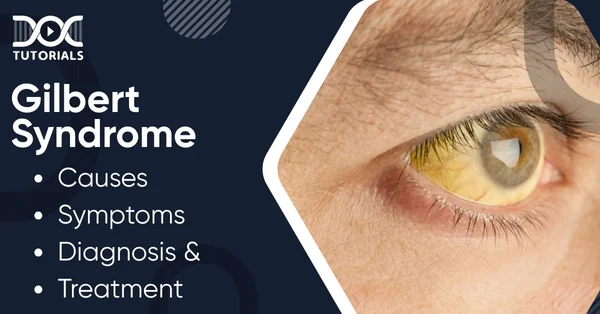Gilbert Syndrome | Causes, Symptoms, Diagnosis & Treatment

Gilbert Syndrome is a health issue that people typically don’t know they have until routine tests reveal something unusual. Most of the time, it doesn’t create severe symptoms, which is why many individuals don’t know they have it for years.
Gilbert Syndrome is more widespread than you might think; it affects about 3% to 7% of people around the world. It’s usually not dangerous, but certain things may sometimes cause it to appear in ways that prompt people to want to know more. Learning about its causes, symptoms, diagnosis, and treatment can help people who have been diagnosed feel better and understand what is going on.
Read on to learn more about Gilbert Syndrome, including its symptoms, causes, diagnosis, and treatment options.
What Is Gilbert’s Syndrome?
Gilbert Syndrome is a moderate inherited liver disease that makes it hard for the body to break down bilirubin, a yellow pigment that forms when red blood cells break down. This happens because an enzyme called UGT1A1 (Uridine-diphosphate glucuronosyltransferase 1A1) doesn’t work as well as it should. This enzyme helps turn bilirubin into a form that can be excreted.
Because of this, unconjugated (indirect) bilirubin can build up in the blood, which can cause mild jaundice, which is when the skin and eyes turn yellow. The syndrome doesn’t hurt the liver and normally doesn’t need therapy. Most people with Gilbert Syndrome don’t know they have it for their whole lives.
What Causes Gilbert Syndrome?
Here are the main causes and risk factors for Gilbert Syndrome:
- A change in the UGT1A1 gene that makes the enzyme UDP-glucuronosyltransferase less active.
- Passed down in an autosomal recessive way, which means that both parents must pass on the faulty gene.
- When the liver can’t break down bilirubin properly, it builds up in the blood as unconjugated bilirubin.
- Stress, illness, starvation, dehydration, or excessive work can cause or exacerbate the condition.
What Are The Signs Of Gilbert Syndrome?
Some of the most common signs of Gilbert’s syndrome are:
- Mild jaundice, which is when the skin or the whites of the eyes turn yellow
- Being fatigued or worn out
- Feeling sick
- Bloating or pain in the stomach
- Not wanting to eat
- Urine that is dark (sometimes)
However, these symptoms are often so mild that people may not notice them or attribute them to something else.
What Are The Things That Make Gilbert Syndrome More Likely To Happen?
There are several factors that can increase the likelihood of developing Gilbert Syndrome. These are:
Genetics
- Gilbert Syndrome runs in families. To have the disease, a person must get the mutant UGT1A1 gene from both parents.
- People who only get one copy are carriers and normally don’t show any symptoms.
- Family History: If you have a family history of Gilbert Syndrome, you are more likely to get it, especially if close relatives have it.
- Gender: More men than women are diagnosed with the illness. Differences in hormones may change how the body breaks down bilirubin.
- Age: Gilbert Syndrome symptoms often appear in teenagers or young adults, when bilirubin levels may change more noticeably.
Ethnicity
- Gilbert Syndrome is more common in people from Europe and North Africa, but it can afflict people of any race.
What Does It Mean To Have Gilbert Syndrome?
To diagnose Gilbert Syndrome, doctors usually do the following:
- A doctor will ask about symptoms like jaundice, family history, and anything that might have caused them, such as fasting or being sick. A physical check can help rule out liver disease indications.
- Blood tests look for high levels of unconjugated bilirubin and liver enzymes, as well as a complete blood count (CBC) to rule out alternative causes of jaundice or anaemia.
- Liver Function Tests (LFTs): These tests assess the liver’s function. People with Gilbert Syndrome normally have normal liver enzyme levels, save for a slightly high amount of bilirubin.
- Genetic Testing: In some cases, particularly when the diagnosis is unclear, a test may be performed to identify mutations in the UGT1A1 gene.
- Doctors may perform a fasting test to determine if bilirubin levels increase, which supports the diagnosis. This is only done in rare cases.
What Is The Gilbert Syndrome Treatment?
Management is all about changing your lifestyle and avoiding things that trigger your emotions. Most of the time, therapies for Gilbert’s Syndrome include:
- No Specific medicine: Most of the time, people with Gilbert Syndrome don’t need to take medicine because it doesn’t create major health problems.
- Avoiding triggers: Taking care of factors that can increase bilirubin levels, such as fasting, dehydration, stress, illness, or excessive work, can help alleviate symptoms.
- Living a healthy life can help keep flare-ups from happening. This includes maintaining a balanced diet, drinking sufficient water, getting adequate sleep, and effectively managing stress.
- Telling Healthcare Providers: It’s vital to let doctors know about the illness, especially before surgery or when giving out prescriptions, because some drugs work differently in people with Gilbert Syndrome.
- Rare Medication Use: In some cases, medications such as phenobarbital may be used to suppress bilirubin levels; however, this is typically not necessary.
Most people with Gilbert Syndrome don’t need regular checkups or therapy.
What Problems Might Gilbert Syndrome Cause?
Gilbert’s Syndrome is not considered a serious condition, and most people can continue their daily lives without issue. But there could be some problems, like:
- Misdiagnosis: Higher bilirubin levels may cause doctors to look into more serious liver problems when they don’t need to.
- Sensitivity to medications: Some individuals may be unable to metabolise certain medications, which can lead to adverse effects.
- Emotional Stress: Finding out you have a genetic ailment might make you anxious, even if the disorder isn’t dangerous.
FAQs About Gilbert Syndrome
- Can Gilbert Syndrome change how I live my life?
Gilbert Syndrome normally doesn’t change how people live their lives. Most people can live normally without making big adjustments to their lives or having to deal with symptoms that are mild and happen only sometimes.
- Is it possible to catch Gilbert Syndrome or stop it from happening?
No, Gilbert Syndrome cannot be passed on. It is a hereditary disorder that you get from your parents and can’t be avoided or caught from other people.
- If I have Gilbert Syndrome, should I stay away from some drugs?
Yes, some drugs can raise bilirubin levels or make you feel bad. Always talk to professionals in Gilbert’s syndrome before taking any new medicines to be sure they are safe.
- Will I need to have regular checkups for Gilbert Syndrome?
You usually don’t need to check in on things regularly until your symptoms get worse. Most persons with Gilbert Syndrome only need to see a doctor regularly and be mindful of their symptoms.
- Does Gilbert Syndrome get worse as you get older?
No, Gilbert Syndrome stays the same and doesn’t get worse with time. It doesn’t hurt the liver or make health problems worse over time.
Conclusion
Individuals aspiring to become doctors and preparing for the NEET PG exam should be aware of Gilbert Syndrome. DocTutorials has everything you need to learn this topic and excel on your test, including comprehensive coaching, interactive video sessions, and rapid review programs.
Check out our NEET PG study materials on additional medical topics to learn better and get the best grades!
Latest Blogs
-
-

NEET SS Exam 2024: Analysis, Key Dates, Counselling
The NEET SS 2024 exam kicked off on March 29, 2025. Over two days and two slots, candidates across 13…
-

NEET PG Registration 2025: An Essential Guide For Exam Prep
The NEET PG registration, which is conducted online, is a crucial step in the exam process. Filling out the NEET…





